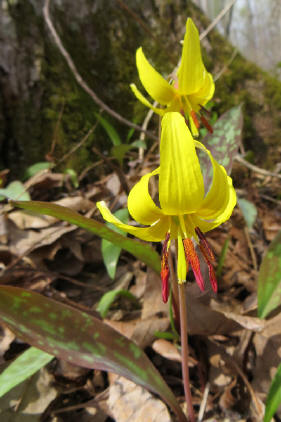 As we reminisce about the 151st Anniversary of the Civil War and Abraham Lincolnís famous Gettysburg Address, here are some gardening techniques that a woman would reflect upon and utilize in 1863.
As we reminisce about the 151st Anniversary of the Civil War and Abraham Lincolnís famous Gettysburg Address, here are some gardening techniques that a woman would reflect upon and utilize in 1863.
The forest is my pharmacy. I use the berries from the dogwood tree for quinine. One of its purposes is an anti-inflammatory agent. The inner bark of the sweet gum tree contains a gummy substance. I boil the substance as a tea, and it serves as a remedy for dysentery. This is a very important tonic because dysentery and diarrhea frequently plague
the soldiers. Undercooked and tainted foods are largely responsible for these demoralizing maladies. Trout lilies are distinguished by an oval leaf and a yellowish flower and they grow wild in the woods. They are useful to relieve hiccups, vomiting, and bleeding from the lower bowels.
My backyard is colorful in appearance and is multifunctional for medicinal purposes. I love my cardinal flower bush because of its brilliant red clusters of flowers, and they are used to cure typhoid fever. Violets are very beautiful and abundant, and they serve as an aid for skin diseases. The juices from my coneflowers are used for snakebites,
insect stings, and toothaches. My beautiful Larkspur aid in relieving asthma and dropsy, and they serve a purpose of healing wounds.
|

Trout Lilies, native plants in meadows and woodlands, have been widely used for both medicinal and culinary purposes. |
Elderberry bushes provide multiple purposes. The tea from the berry is extracted for cold and cough discomforts. Hot toddies of mulled elderberry wine provide soothing comfort from distress. Tea made from the flower is a mild laxative. The roots are used for black dyes, the leaves for green dye, and the berry for purple dye.
The extract of the fennel root is beneficial as the treatment of cataracts. A tea made from the crushed seed is used for an eye wash and also serves as relief from stomachaches and cramps. I hang the fennel over the door of my home to repel evil spirits.
The beautiful forget-me-not plants are pleasing to the eye, and they serve other purposes. A poultice from the forget-me-not plant aids in the treatment for insect bites and venomous animal bites.
I make a cordial from the blackberry root that is useful for dysentery and similar ailments. Ripe persimmons also serve the same purpose. I use an extract from the bark of wild cherry, dogwood, and poplar as a remedy for chills. I grow horehound and boil it as a tea for the same effect.
I grow blackberry and huckleberry bushes, and then dry the leaves to make a delicious tea. The leaves of the Jack-in-the-pulpit reduce swelling from rattlesnake bites.
I have become quite proficient at digging up large dandelion roots. I dry them, then dice them and roast them until they are dark brown. I then ground and brew them to make a cup of "coffee." I put one ounce of the leaves into boiling water, stir, steep, remove the leaves, and sweeten to taste.
Skunk cabbage is abundant and easy to grow. The leaves are brownish-purple and green mottled. They are covered with tiny white flowers in the spring. I use the skunk cabbage as an expectorant and respiratory sedative and also for acute asthmatic attacks.
My vegetable garden contains abundant corn because its uses are limitless. I burn the cobs and use the ashes of the corncobs. They serve as bicarbonate of soda because of its alkaline content. I prefer the red cobs because they raise my bread the best.
Essential oil extracted from my lavender eases head pain, apoplexy and cramps. Lavender water made by steeping the flower in wine is used for intestinal gas and as a breath gargle. The dried flowers repel moths and make lovely sachets.
Camp itch is an annoying problem among the soldiers. A concoction of poke root is used for bathing to soothe the problem areas. The Mayapple and the Pokeweed are used to treat liver disorders.
The women during the Civil War were angels of mercy, ministering to the wounded soldiers. They worked the soil, growing plants for sustenance, and herbs for healing. Mother Nature was their friend and ally, and they knew how to use her to their advantage for survival when their environment was troublesome and uncertain.
Read other articles on garden and landscape design
Read other articles by Carolyn Black